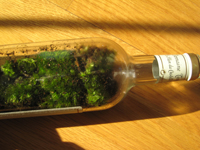| Scientific Name | Psidium cattleianum |
| Common Name | Strawberry guava |
| Purple guava |
| Cherry guava |
Strawberry Guava is a small tree, native to Brazil, that grows to about seven meters(23 feet) in height but is generally much smaller. The strawberry Guava is a very hardy plant that needs full sun for optimal growth and plenty of water when bearing fruits. They are generally located in geographically high regions where the average temperature is much cooler.
Bunch of strawberry guava
You get lots of fruits
Even low branches get fruits
Most of them are not ripe yet
However, there is a dark side to this plant:: It is an invasive plant. It is now considered as a weed in the tropics(even here in Mauritius).By the way, here it is called
goyave de chine, literally translated to Guava of China.
According to the
Invasive Species Specialist Group(ISSG) Database:
Psidium cattleianum is native to Brazil, but has been naturalised in Florida, Hawaii, tropical Polynesia, Norfolk Island and Mauritius for its edible fruit. It forms thickets and shades out native vegetation in tropical forests and woodlands. It has had a devastating effect on native habitats in Mauritius and is considered the worst plant pest in Hawi, where it has invaded a variety of natural areas. It benefits from feral pigs (Sus scrofa) which, by feeding on its fruit, serve as a dispersal agent for its seeds. In turn, the guava provides favourable conditions for feral pigs, facilitating further habitat degradation.
It is not obvious that it is an invasive plant here. Each year, thousands of Mauritians go on a strawberry guava hunt, when its the season(February-April), in the large fields of strawberry guava. The lucky ones(generally the first ones) return back home with bags full of fruits. Excess of strawberry guava is turned into a delicious jam. Unfortunately, the population takes the strawberry guava "forests" for granted and are not aware that it is some kind of invasion.
Their yummy flesh are similar to guavas
Propagation is very easy. Done by seeds, cuttings, layering or whatever method you like.
Read more...













